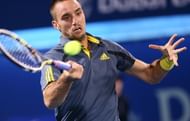In 2010, when Serbia conquered all corners en route a maiden Davis Cup triumph, they did so on the might of four top class players, three young, classy singles exponents and a wily, old doubles specialist. While Novak Djokovic was and remains the kingpin amongst the lot, the remaining trio of Janko Tipsarevic, Viktor Troicki and Nenad Zimonjic were playing at a level where they were able to win rubbers even without him. However, while Tipsarevic has come on leaps and bounds since then, the dip in form of Troicki (who does singles duty when Djokovic sits out) has seen the collective might of the Serbian side decrease, particularly when the opposition has a strong doubles combination.
The individual rankings of the three singles players then and now tells a tale in itself. By the time the decider against France came up in 2010, Djokovic was ranked world No 3. Now he is rightfully at the top of the pile in the men’s game, on the back of an incredible two and a quarter years that has seen him capture three straight Australian Opens, one Wimbledon, one US Open and reach the semifinal or final at each of the last 11 Slams he has played, dating back to Wimbledon 2010. Tipsarevic was very much the third fiddle in the 2010 Serbian lineup, as was evidenced by the selection of Troicki over him for the deciding rubber against France. Tipsy was ranked in the 40s back then but has over the last year shot into and consolidated a top 10 slot, and is currently ranked 9th in the world.
But Troicki’s rankings, form and results have taken a nosedive since that memorable November night in Belgrade, all the way from a career-best 12 (early 2011) to 44 currently. However, judging by the talent of the 23-year-old, this is indeed quite a shock. While his compatriots have grown from strength to strength, increasing the efficiency of their go to strokes and working tirelessly to nullify their weaknesses, Troicki’s game has degenerated on multiple counts.
While he still has a big serve, his first serve percentage in most big matches is extremely poor for it to become a factor. While he still hits a few mean groundstrokes, he tends to go for the spectacular winner far too early in rallies instead of playing the percentage points. His physical stamina remains a plus even today but his mental frailties are his biggest weakness, and to me, the root cause of 90% of his problems.
Indeed, Troicki’s current problems offer a throwback to the Djokovic of old – bundles of talent and promise side by side a frustrating inability to deliver when it matters, mostly due to a brash temperament. While most pundits point to Djokovic’s switch to a gluten-free diet and a resulting tantamount difference in his stamina as the main reason behind his sensational form over the last two years, the oft neglected yet arguably the greatest change in his game has been a new-found ability to keep ice cool under pressure.
Of course, comparing today’s Troicki to the pre 2011 Djokovic is doing the latter a huge disservice. Not only had Djokovic reached the top three in the world by that time, he had also won a Slam – the 2008 Australian Open. But it is his inability to replicate that triumph till three years later that is being put under the focus.
The second he got his mind under control, the day he stopped bouncing the ball 20 and 30 times before a serve, the time he managed to strike a balance between being a court jester and a competitive professional, a new Djokovic emerged. The one we’re used to seeing nowadays – who blasts fearless crosscourt winners down two match points in the semifinal of the US Open against Roger Federer; the one who got under Rafael Nadal‘s skin on clay; the one who at the same time runs as much as David Ferrer, turns defence into attack a la Bjorn Borg, returns serve off both sides like Andre Agassi, and backs up the best double-handed backhand in today’s game with a solid forehand, an ever-improving net presence and crafty, deceptive drops.
If only Troicki can get his mind under control like his compatriot or at least, even as much as Tipsarevic does, he has the potential to crack the top 10, if not go further. If he does manage this, Serbia could be set for a good five-six years of Davis Cup dominance much like Spain’s glory run in the first decade of the century.
How did Novak Djokovic meet Jelena Ristic? All about the most admired couples in tennis

